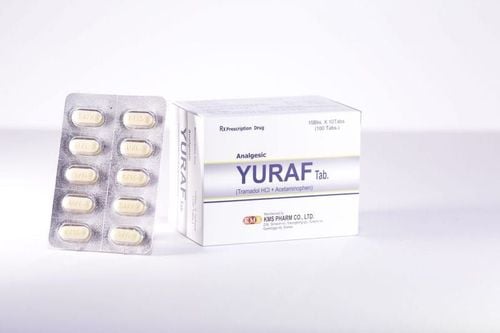This is an automatically translated article.
Nalsarac belongs to the group of pain relievers, antipyretics, non-steroidal anti-inflammatory drugs widely used in the treatment of Gout and osteoarthritis. Nalsarac has the main active ingredients Paracetamol 325mg and Tramadol HCl 37.5mg. Nalsarac is available as a film-coated tablet.1. What are the effects of Nalsarac?
Nalsarac is indicated for the treatment of:
Moderate to severe pain: Toothache, abdominal pain, headache, muscle aches,... Treatment of colds, fever: Runny nose, stuffy nose, inflammation nose, watery eyes, sore throat, cough,... Patients who work too hard have musculoskeletal pain. Feeling pain due to accident, sports injuries.
2. Dosage and how to take Nalsarac
Nalsarac is used for oral administration.
Dosage is adjusted depending on the age and condition of each person:
Adults and children > 12 years: The maximum dose is 1 to 2 tablets every 4 to 6 hours and not more than 8 tablets in 1 day. The process of taking the drug is not affected by food. Children < 12 years: Safety and effectiveness have not been studied in children. Elderly people > 65 years old: Safety, pharmacokinetic properties, and pharmacodynamics in this age group are not different from those of younger patients.
3. What to do in case of an overdose of Nalsarac?
Patients who accidentally overdose on Nalsarac may experience some symptoms of Tramadol and Paracetamol poisoning.
Tramadol overdose can cause serious consequences such as: respiratory failure, coma, convulsions, cardiac arrest and death. Taking very high doses of Paracetamol can cause liver toxicity, possible symptoms include: Gastrointestinal irritation, loss of appetite, nausea, vomiting, irritability, paleness, sweating. Symptoms of hepatotoxicity may appear 48-72 hours after taking Nalsarac. Patients should notify their doctor or immediately go to the nearest medical facility when experiencing any emergency when overdose.
4. Contraindications to taking Nalsarac
Nalsarac drug should not be used in the following cases:
People who are sensitive to Paracetamol or any other ingredient in the drug. Patients with severe renal failure Children < 6 years of age Do not use Paracetamol for pregnant and lactating women. People with G6PD deficiency Anemia People with heart, liver, kidney, lung disease or bronchospasm.
5. Nalsarac drug interactions
When using two or more other drugs in combination, drug interactions may occur. The following are some drugs that, when combined with Nalsarac, can cause drug interactions:
Concomitant use with MAO inhibitors, Serotonin reuptake inhibitors may increase the risk of occurrence. seizures and Serotonin syndrome. Concomitant administration of Tramadol hydrochloride with Carbamazepine significantly increases metabolism and the analgesic effect of Tramadol in the drug may be attenuated in patients taking Carbamazepine. Concomitant use of Quinidine with Tramadol will increase the concentration of Tramadol. Use of Nalsarac with Warfarin Substances: Periodic assessment of extrinsic clotting time is required when these drugs are co-administered as increased INR has been reported in some patients. There are data to suggest that the co-administration of Tramadol with CYP2D6 inhibitors such as fluoxetine, paroxetine and amitriptyline may limit drug metabolism when studied in vitro for drug interactions on human liver microsomes. Concomitant use of active ingredients Tramadol with Cimetidine did not change the pharmacokinetics of Tramadol in clinical terms.
6. Side effects when using Nalsarac
During the treatment with Nalsarac, the patient may experience some undesirable effects that usually occur mainly on the central nervous system and digestive system such as:
Dizziness, dizziness, drowsiness or loss of vision. sleep, fatigue, weakness, strong emotions, headache, shivering, migraine, severe migraine, nausea, abdominal pain, indigestion, flatulence, vomiting, constipation or diarrhea,... experience any side effects including those not listed above. Please contact your doctor, pharmacist or go to the nearest medical address for proper examination and treatment.
7. Pay attention to precautions when using Nalsarac for treatment
Patients can refer to some notes when taking Nalsarac as follows:
Caution should be taken when using tramadol concurrently with SSRIs, TCAs, Opioids, MAOIs, tranquilizers or drugs that lower the seizure threshold because there are risk of convulsions. Use with caution in patients with epilepsy, history of convulsions or at risk of convulsions, who are at risk of respiratory failure. High doses of Tramadol should be used with caution with drugs that depress the central nervous system such as: anesthetics, anesthetics, sleeping pills, sedatives, Opioids, alcohol. Use of the drug in patients with increased intracranial pressure or head trauma should be carefully monitored. Nalsarac when used in patients with chronic alcoholism can cause the patient to relapse and cause liver toxicity. An overdose of Tramadol and the use of Naloxone may increase the risk of convulsions. In patients with renal impairment with creatinine clearance < 30 ml/min, the dose should not exceed 2 tablets every 12 hours. Use with caution in patients with severe liver failure. Do not exceed the prescribed dose of Nalsarac. Do not use with drugs containing Paracetamol and Tramadol. Above is all information about Nalsarac drug, patients need to carefully read the instructions for use, consult a doctor or pharmacist before taking the drug. Absolutely do not arbitrarily buy Nalsarac treatment at home because there may be unwanted side effects.
Please dial HOTLINE for more information or register for an appointment HERE. Download MyVinmec app to make appointments faster and to manage your bookings easily.













